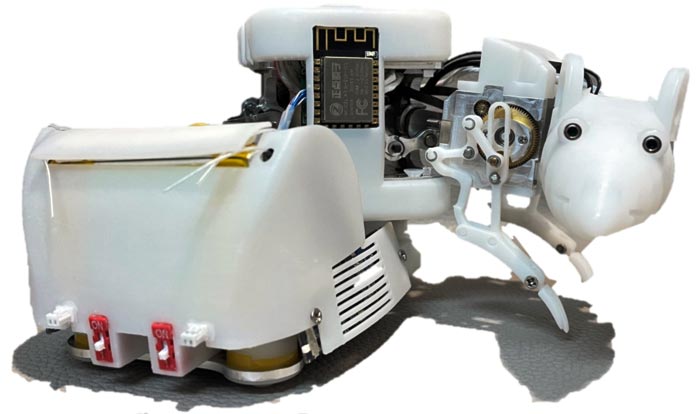A step towards natural interaction between robots and animals

This biomimetic robotic rat equipped with a miniature vision perception system has 9 active degrees of freedom. Based on its agile rat-like motion, the robot can interact autonomously with actual rats.
Credit: Cyborg and Bionic Systems
Laboratory rats have been shown to have genetic consistency and similar responses to drugs with humans, and thus become ideal animal models for research and testing of new drugs. However, due to individual difference, it is still a challenging task to find a method of unified behavior control and evaluation.
Actually, bioinspired robots can take advantage of their programmability and reconfigurability to replace rats, so as to effectively solve these problems. It has been verified that robots can influence or even control the behavior of actual rats to a certain extent during robot-rat interaction. Some researchers have done a lot of work related to the autonomous interaction. However, those studies still lack behavior detection, fast object tracking and automatic interaction framework.
Recently, a team of scientists from Beijing Institute of Technology, China proposed an automatic robot-rat interaction framework that enables a robotic rat to realize real-time localization, tracking and movement analysis of a laboratory rat (Rattus norvegicus) on IROS 2021. The preliminary robot-rat interaction tests show that the robot is able to track a fast-moving rat for a duration of 10 minutes steadily.
To the best of their knowledge, it is the first time that a rat-sized robot achieves a continuous tracking of actual rats by a built-in miniature stereo vision system. Experimental results show that the sequence of state vectors can characterize some typical behaviors of the actual rat.
What’s more, the team also designed a quadruped robotic rat by mimicking the morphological and kinetic characteristics of rats. Compared with other quadruped robotic rat, the newly developed robotic rat features smaller turning radius, higher walking velocity and strong capability.
Moreover, the new quadruped robotic rat shows high adaptability in crossing irregular passages, climbing slopes, surmounting obstacles and recovering from falls. These capabilities enable it to resolve difficulties of passing through narrow spaces and performing tasks simultaneously. Apart from operating in narrow spaces, the robotic rat could also benefit behaviour reasearhes by promoting the autonomy and reproducibility of rat-robot intereaction experiments.
Journal: Cyborg and Bionic Systems
Method of Research: News article
Subject of Research: Not applicable
Media Contact
Ning Xu
Beijing Institute of Technology Press Co., Ltd
xuning1907@foxmail.com
All latest news from the category: Information Technology
Here you can find a summary of innovations in the fields of information and data processing and up-to-date developments on IT equipment and hardware.
This area covers topics such as IT services, IT architectures, IT management and telecommunications.
Newest articles

A universal framework for spatial biology
SpatialData is a freely accessible tool to unify and integrate data from different omics technologies accounting for spatial information, which can provide holistic insights into health and disease. Biological processes…

How complex biological processes arise
A $20 million grant from the U.S. National Science Foundation (NSF) will support the establishment and operation of the National Synthesis Center for Emergence in the Molecular and Cellular Sciences (NCEMS) at…

Airborne single-photon lidar system achieves high-resolution 3D imaging
Compact, low-power system opens doors for photon-efficient drone and satellite-based environmental monitoring and mapping. Researchers have developed a compact and lightweight single-photon airborne lidar system that can acquire high-resolution 3D…





















